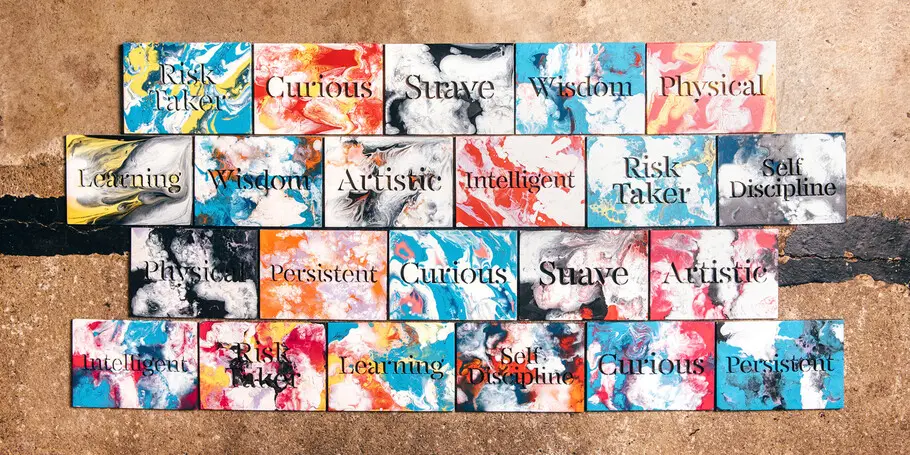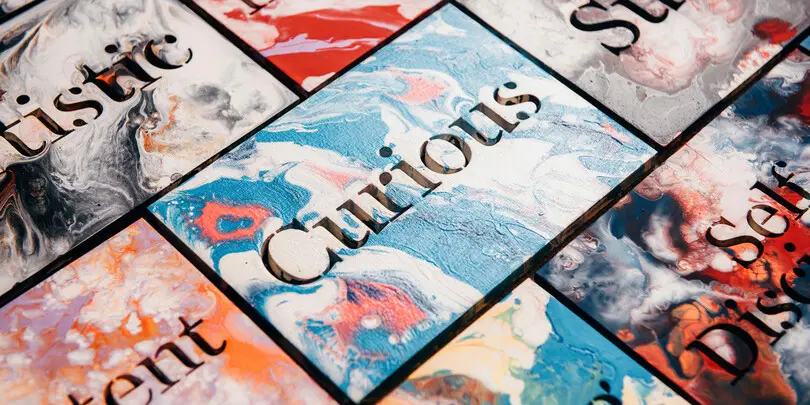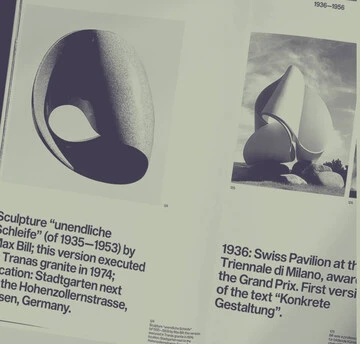Craig Black x Pedro Arilla インタビュー.

Craig Black.
FS Renaissanceは、芸術とデザインの融合を追求した手づくりのディスプレイフォントです。各文字が独立したアート作品でありながら、全体として技術的に調和した美しい書体とデザインを形成します。このフォントは、著名なグラフィックデザイナー兼レタリングアーティストのCraig BlackとMonotypeのクリエイティブ・タイプディレクターPedro Arillaのコラボレーションによって誕生しました。美と機能のバランスを追求しながら、アーティストとタイプデザイナーが手を取り合い、アートとデザインの新たな可能性を探る一歩をあなたもぜひご覧ください。
CraigとPedroは最近、FS Renaissanceの背景にあるコンセプトや制作プロセスについて、彼らの視点を共有しました。
書体のオリジナルコンセプトは何でしたか、またどのようにして方向性を決定しましたか?
Craig:「ルネサンス・マン」という言葉は、ルネサンス期に生きた(そしてその牽引役となった)最も才能ある芸術家、発明家、科学者、思想家のことを指す造語です。ルネサンスは芸術、科学、学問、哲学の隆盛期であり、一般的に14世紀に始まり16世紀まで続いたとされています。
私はいつも、性別に関係なく、この時代を生きた人々を尊敬し、彼ら/彼女らがさまざまな分野にわたって信じられないほど多様なスキルを身につけたことに感心してきました。特に魅了されるのは、彫刻作品とタイポグラフィの石彫り技術です。私はその複雑さが大好きで、このような美しい作品を生み出すために必要だったに違いない忍耐力に感服します。
これらすべてのことに触発され、ステンシル・タイポグラフィという現代的な影響と組み合わせることで、私が抱いている尊敬の念を象徴する書体をつくることにしたのです。私はPedroとなら、この独創的なコンセプトを次のレベルに引き上げ、特別なものを一緒につくることができると思いました」
Pedro、初めてCraigのコンセプトを見たときは、どのように感じましたか?
Pedro:「一目惚れでした。私はCraigの作品をかなりよく知っていたので、驚かされることは予想していましたが、これほどのものが来るとは思いませんでした。それは洗練されたタイポグラフィの一種でありながら、レタリングアーティストだけがその中に埋め込むことができる、自信に満ちた態度を備えたものでした」
デザインはどのように進化したのでしょうか、そしてその理由は何ですか?
Pedro:Craigのオリジナルデザインは非常に良かったのですが、それをタイポグラフィのシステムとして機能させるのは別の課題です。最初の「すごい」という瞬間の後、私はディテールに目を向け始めました。核となるアイデアはそこにあり、とても力強いものでしたが、システムを構築する方法、プロポーション、黒と白のバランス、そしてタイプデザイナーが執着するあらゆる要素について話し合う必要がありました。
私たちは元のコンセプトを損なうことなくそれを実現する方法について議論しました。それは主に、クレイグの作品の真のDNAを見つけ出し、タイポグラフィの基盤に適用することでした。デザインはそれほど進化しなかったと言えるかもしれませんが、成熟し、非常に落ち着いたものになりました。
Craig:Pedroが言ったように、書体は私のオリジナルのスケッチからそれほど進化しませんでしたが、タイポグラフィのシステムとして機能させるためには少しの調整が必要でした。Pedroの職人技への献身とディテールへの目配りは、書体のバランスと流れに大いに貢献しました。
クリエイティブプロセスには何人のデザイナーが関与しましたか? またどのように協力しましたか?
Craig:私はコラボレーションの力を強く信じていますが、Pedroとの協力はこれまでの中でも最高の一つでした。私たち二人は密接に連携しながらフォントの複雑さを整理しました。私はオリジナルのスケッチを作成しましたが、その後Pedroにバトンを渡し、彼に魔法をかけてもらいました。彼は期待を裏切りませんでした。作業が進化するにつれて私たちの関係も発展し、それがより良いコラボレーションと、アイデアや課題をよりオープンに議論できる場を生み出しました。
Pedro:基本的には、私たち二人が定期的に話し合っていました——時にはこの特定のプロジェクトについてではなく、デザインやアートについて話すこともありました! Craigは最初から私を信頼してくれていたので、彼のレシピに従って書体開発を始めました。文字セットが増え始めると、ますます多くのデザイン上の判断を下す必要が出てきたので、彼に逐一状況を共有するようにしました。書体をデザインする際、もう一つの視点があることはいつでも非常に役立ちますが、今回は特に重要でした。Craigのフィードバックと意見はいつも洞察に富み、前向きなものでした。
FS Renaissanceをどのように説明しますか?
Pedro:基本はトランジショナルセリフですが、ステンシルのような特徴が追加されています。より感覚的な観点から言えば、FS Renaissanceは優雅な輪郭と時代を超えた風格を持つディスプレイ書体だと言えます。そこには壮大な何かがあります。ナポレオンの言葉を借りれば、これらの文字形の頂きから、5世紀にわたるタイポグラフィの歴史が私たちを見下ろしているのです。

デザインで特に気に入っている要素は何ですか?
Craig: 特に文字形全体に見られる洗練さが大好きです。各文字は、それ自体の価値において美しく優雅につくられた芸術作品として扱うことができます。それらを組み合わせることで、デザインとアートの間に微妙なバランスが生まれます。これは私が非常に誇りに思っていることです。
Pedro:私は特に質感を誇りに思っています。このフォントはディスプレイ書体でありながらも、質感が重要であり、黒と白、つながった要素と切り離された要素、そしてデザインとアートの間に美しいバランスが存在しています。
この書体が市場にある他のディスプレイフォントと異なる点は何ですか?
Pedro:私にとっては、そのシンプルな公式です。普段、ステンシル書体はあまり好きではないのですが、これは別物です。切り込みが硬直しておらず、この書体は光と踊っているような印象を与えます。その結果、とてもユニークで内面的な優雅さが生まれています。
Craig:私もPedroの意見に完全に同意します(ただし私はステンシル書体が大好きですが!)。公式のシンプルさが、この書体をうまく機能させているのです。個々の文字を構成するために使用される形状の組み合わせが、それ自体で美しい芸術作品をつくり出しているのです。
Q: どのような用途に使えますか?
Pedro:見出し、ポスター、表紙…気品と繊細さを示し、洗練と上品さを表現する必要があるものなら何でも。FS Renaissanceはステンシル書体に対する不遜なアプローチなので、より残忍なデザインの対比要素として使うこともできます。

どのようなものと組み合わせると良いでしょうか?
Pedro:本文にはセリフ体でもサンセリフ体でも問題ありません。ただし、FS Renaissanceの理想的な組み合わせは、タイポグラフィの純粋さを強調する非常に幾何学的なサンセリフ体です。
なぜFS Renaissanceという名前なのでしょうか?
Craig:レオナルド・ダ・ヴィンチの天才性はいつでも私をインスパイアしてきました。彼は多くの分野で卓越した人物です。画家、彫刻家、植物学者、数学者であり、他にもさまざまな顔をもっていました。彼は飛行機の原型を発明し、人間の解剖学を研究し、自身の生涯の中で偉大で(そして明らかに永続的な)名声を手に入れました。
他の人物とダ・ヴィンチを差別化していたものは何だったのでしょうか? その一部一つは、彼が絶対的な天才だったことです。しかし、彼が自分の興味を絶え間なく追求したという事実こそが、人生で多くの業績を達成し、ルネサンス・マンとしての遺産を築いたのです。
ダ・ヴィンチの遺産は現代の人々と思想にインスピレーションを与えてきました。
現代のルネッサンス・マンになるということは、必ずしも優れた詩人や彫刻の達人になることを意味するわけではありません。それよりも、世界に対して可能な限り心を開き、訪れるすべての機会を受け入れることです。それは心を鋭く保ち、体調を良好な状態に保つことを意味します。なぜなら、心がその可能性を最大限に発揮するためには、健康な体を必要とするからです。それはできる限り多くを学ぶことを意味します。それは旅をして世界を見てまわり、人々と交流し、言語を学ぶことを意味します。それは自分であることを恐れず、自分自身の存在に自信をもつことを意味します。
これらの特徴は私自身の性質に影響を与えており、それを書体を通じて表現したいと考えました。
ローンチコンセプトの背後にあるアイデアについて少し説明していただけますか?
Craig:私はルネサンス期の絵画、彫刻、建築に影響を受けました。その形状や色彩の組み合わせは非常に調和しており、美しいバランスを生み出しています。このことが私のアクリル・フュージョン絵画技法における動機付けとなりました。私はこの時代を、自分自身の解釈によるタイポグラフィ彫刻と色彩の融合を通して表現したいと考えました。デザインとアートの世界を結びつけ、互いにどのように影響を与え合うかを示すことが重要でした。そのため、これらのタイポグラフィ彫刻はそれ自体が一つの芸術作品として制作されたのです。
ルネサンス時代の芸術作品を鑑賞するとき、私はいつも「これはどうやってつくったのだろう? どうやって生み出されたのだろう?」と疑問に思っていました——とくにそれらが生まれた時代のことを考えると。この疑問によって、私はルネサンス・マンは時代のはるか先を進んでいたのだと考えるようになり、自分の作品を通じてこの疑問を表現したいと思うようになりました。ルネサンス期の芸術作品のように、できる限りすべて手作業で制作し、タイポグラフィ彫刻の構成や制作方法を、人々に問いかけるようにしたかったのです。
だから私は、優れた写真家であり素晴らしい人物でもあるSusan Castilloとコラボレーションしました。彼女のスタイルと細部へのこだわりはこのプロジェクトに完璧にマッチし、彼女はこの問いかける思考に本当に命を吹き込んでくれました。
FS Renaissance は現在、MyFonts および Monotype Fonts プラットフォームからご購入いただけます。
















